How I learnt the art of ketupat weaving from my mother-in-law and what it taught me about family
CNA Women's Izza Haziqah learns how to weave the traditional ketupat – a skill that requires patience, dexterity and lots of love for culture – from her expert mother-in-law.
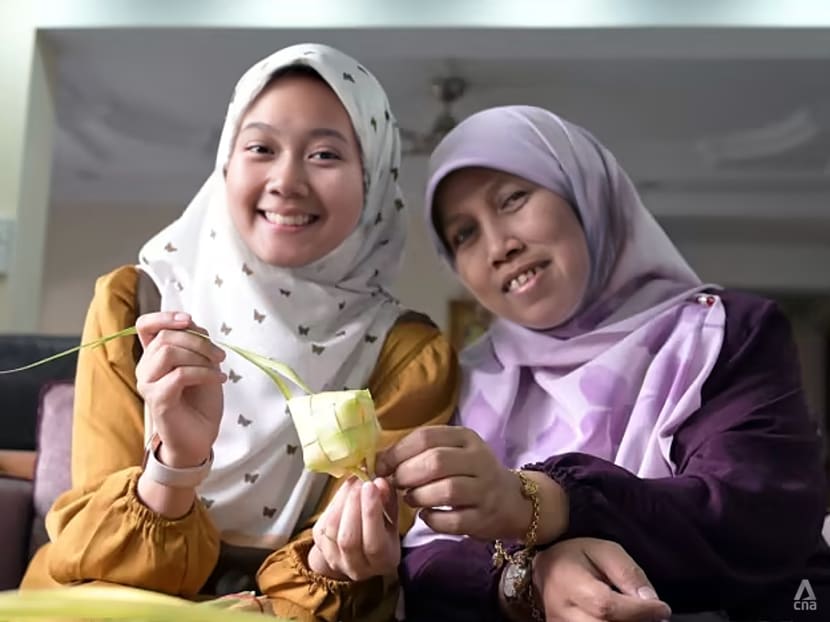
My mother-in-law and me (left) with the ketupat I made and she improved on. Yes, that still counts. (Photo: CNA/Raydza Rahman)
For me, the highlight of every Hari Raya celebration is the food. I eagerly anticipate the fragrant rice dishes, beef rendang, sambal goreng, sambal udang, lauk lemak and more.
In my parents’ household, the whole family would work together to prepare these dishes. Accompanying them will be the handmade ketupat we bought in Geylang Serai, and the result is a beautiful, delicious feast to welcome the festivities.
Since I got married and joined my spouse’s family, I’ve discovered a new dimension to the festivities – the joy of preparing the ketupat at home.
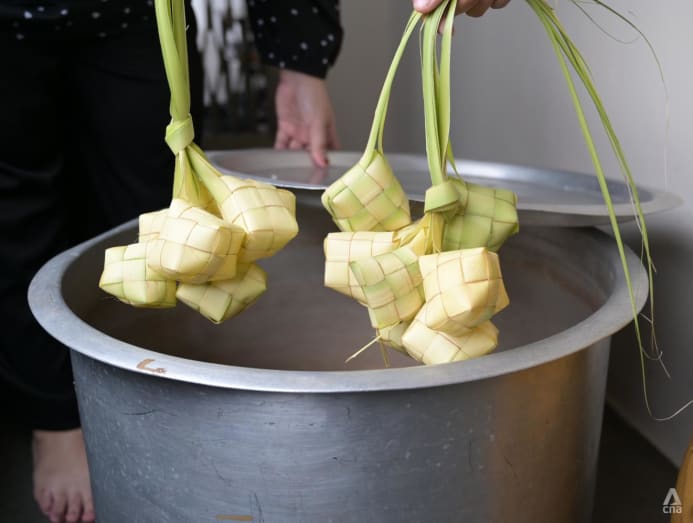
Every year, my in-laws would weave the ketupat in the cosy space of their living room. A delicate and beautiful art passed down through generations, ketupat weaving in this family is now led by my mother-in-law, Nura Abdullah, who first learned how to weave it when she was 11 years old.
A tradition unique to the people in the Malay archipelago, ketupat is made of two strips of janur leaves (young coconut leaves), woven together in a crisscross pattern. “The crisscross design symbolises togetherness and unity,” my mother-in-law told me. “These two values are very close to the Malay tradition and the celebration of Hari Raya.”
Having weaved ketupat every festive season for over 40 years, my mother-in-law preserves the art by ensuring that her children are also adept at this skill. And it shows – all her children are familiar with the practice, and they too see its significance.
Ketupat is the traditional rice cake served during Hari Raya Aidilfitri – we tried our hand in making the pouch from scratch and it wasn’t easy.
Weaving the ketupat involves several steps. First, separate the coconut leaf from its spine. Don’t throw away the spine yet, as it can be repurposed into a broomstick. The pliable part of the spine can also be used as a string for tying the ketupat.
After that, wrap one part of the coconut leaves onto your right and left hand, three or four times depending on the size of the ketupat.
Hold the end of the leaf tightly on both hands and insert the leaf coil, right over left, and continue in this manner, which will bring about the crisscross pattern.
Once the weaving is done, you can tighten the ketupat by pulling gently on the “tail”. The tightness will prevent the rice from falling out before it’s time to boil it. The long length of the “tail” also helps you retrieve the ketupat once it’s cooked.
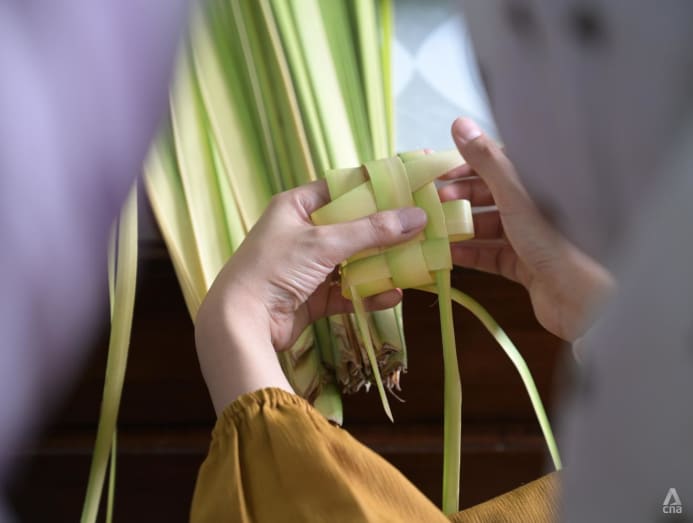
For my mother-in-law, ketupat weaving is a treasured family tradition that has been passed down from one generation to the next. Each time she sits down to weave, she feels the presence of her mother, who taught her the craft with patient hands and was, in turn, taught how to weave by her own mother.
The weaving is also a family affair that brings people together, embodying the values of the ketupat’s pattern. I got to experience how communal the practice was when I first learned how to weave on the eve of Hari Raya Puasa a year ago.
The whole family gathered in the living room and we were like a production chain where the steps included cutting up the janur leaves, weaving the ketupat casing, adding rice into that casing and boiling the ketupat in a large pot in the kitchen for hours before being served. The rice cakes are enjoyed with the rest of the traditional dishes.
The atmosphere was filled with warmth and lively conversation, creating a sense of connection that strengthens as we worked on the ketupat together.
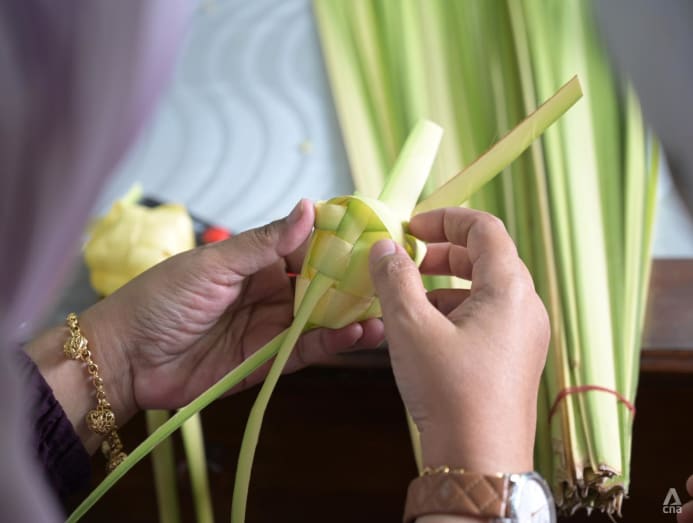
Admittedly, the first time I attempted to weave, I struggled badly. I was clumsy and uncoordinated, and the leaves kept falling out of shape from my fingers.
Had I been doing it alone, I would have easily given up. But because I did it with my family and was supported by my mother-in-law, sister-in-law and brother-in-law, and not wanting to “miss out”, I kept at it and eventually improved – slowly but surely.
Unsurprisingly, as I struggled to even complete the first step – creating the skeletal base of the ketupat – my mother-in-law could finish the entire thing, tightened and ready for boiling, in under three minutes.
When she first started learning how to weave the casing of the ketupat, she would only work on the last part – tightening the woven structure of the leaves and ensuring that all the gaps are covered. It was only after she was good at tightening did she start weaving them from scratch.
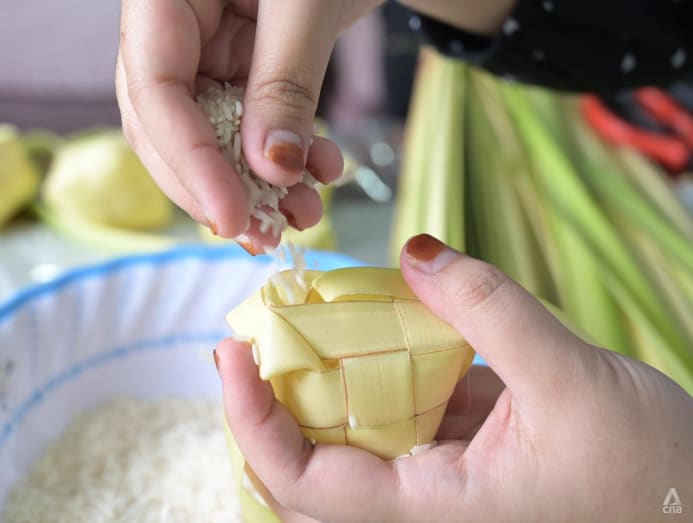
With more ready-made ketupat available in the market, some families choose to skip the process and buy the ketupat instead of making them by hand, especially since it may be too time-consuming and difficult.
“But even if we can’t do it at home, we can still maintain the tradition by buying directly from the weavers, like some stalls in Geylang Serai,” my mother-in-law said.

These days, lots of ketupat weaving tutorials are available on platforms such as Instagram and TikTok, giving the younger generation a chance to learn how to weave. Though, of course, if you ask me, you can't compare this to learning directly from a loved one who is also an expert.
“It’s a long process,” my mother-in-law said. “What’s important is that you keep trying, and don’t give up.”
CNA Women is a section on CNA Lifestyle that seeks to inform, empower and inspire the modern woman. If you have women-related news, issues and ideas to share with us, email CNAWomen [at] mediacorp.com.sg (CNAWomen[at]mediacorp[dot]com[dot]sg).







